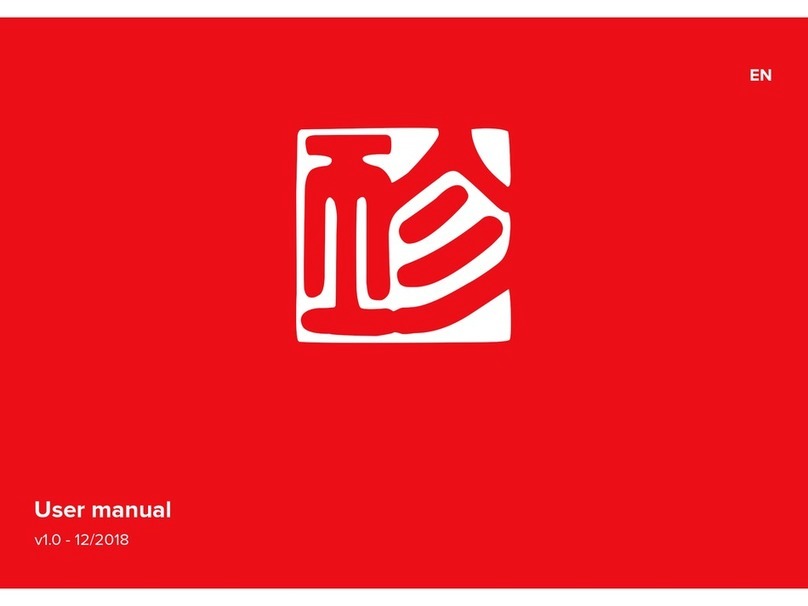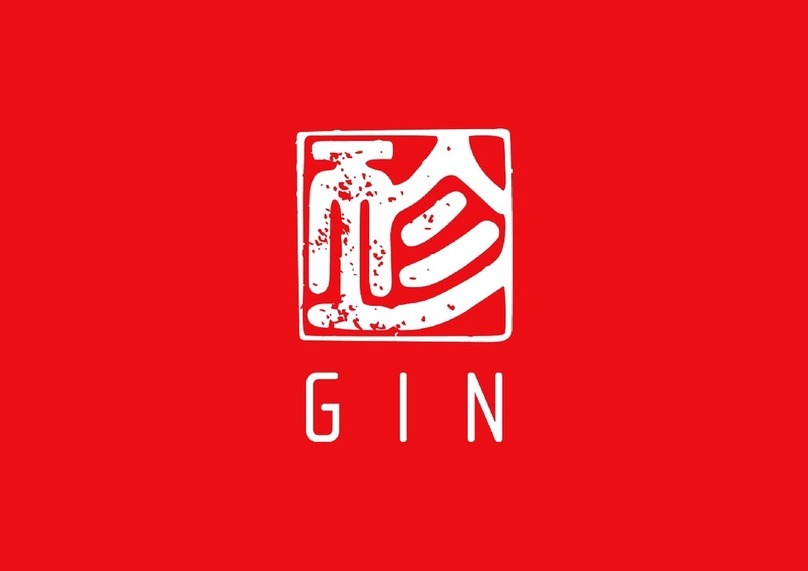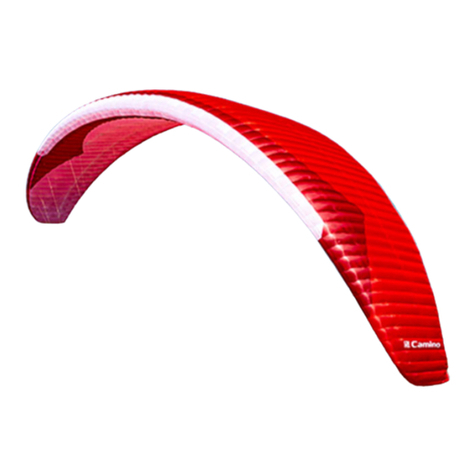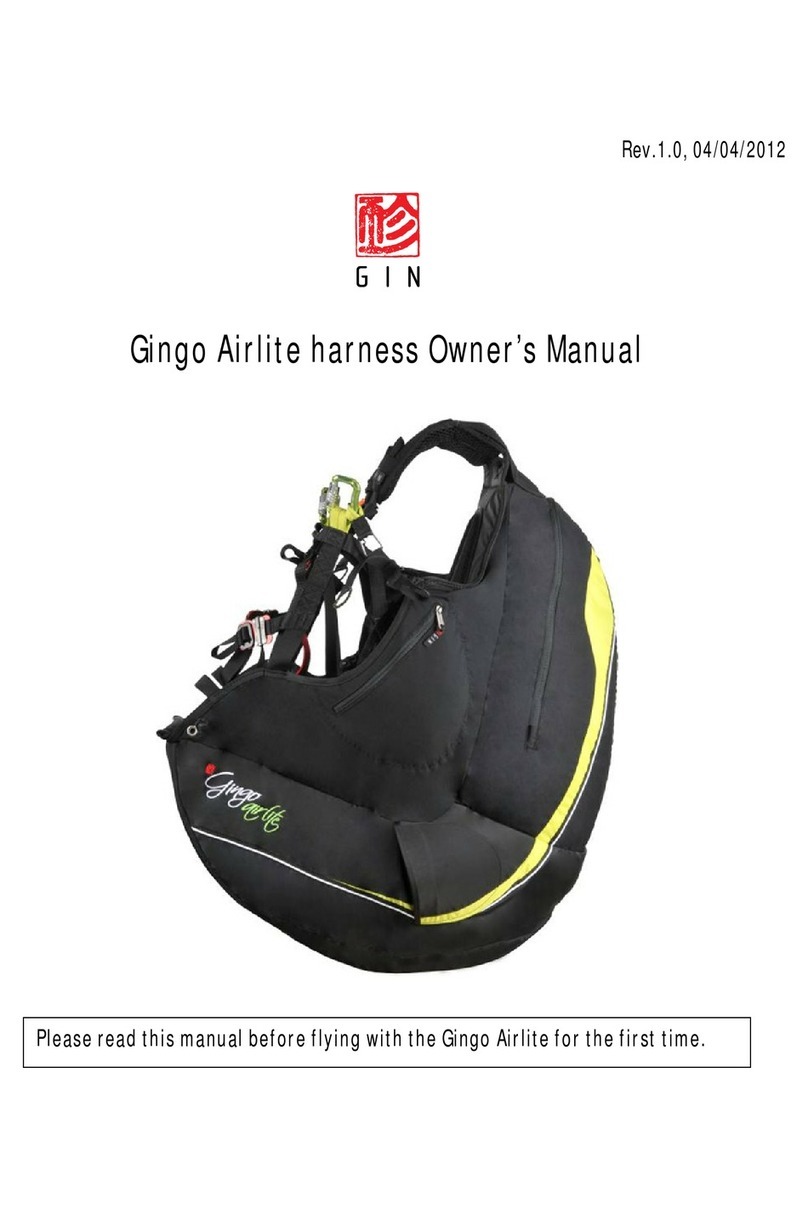Gin Gliders Gingo Airlite XS User manual

1

pilot manual
v1.2 04/2016

3
Intermediate lite
airbag harness

4
Contents
Thank you
Warning
About Gin Gliders
Introducing the Gingo Airlite
Specifications
Before you fly
Flying with the Gingo Airlite
Maintenance and repairs
Final words
Technical data
Materials
Harness diagram
...................................................................5
.....................................................................6
.......................................................7
......................................8
.............................................................9
............................................................13
....................................26
..........................................29
...............................................................32
...........................................................33
..................................................................34
.......................................................35

5
Thank you...
...for choosing Gin Gliders. We are confident you’ll enjoy many rewarding experiences in the air
with your GIN harness.
This manual contains important safety, performance and maintenance information. Read it
before your first flight, keep it for reference, and please pass it on to the new owner if you ever
re-sell your rescue.
Any updates to this manual, or relevant safety information, will be published on our website:
www.gingliders.com. you can also register for e-mail updates via our website.
Happy flying and safe landings,
GIN team

6
Warning
Like any extreme sport, paragliding involves unpredictable risks which may lead to injury or
death. By choosing to fly, you assume the sole responsibility for those risks. You can minimize the
risks by having the appropriate attitude, training and experience and by properly understanding,
using and maintaining your equipment. Always seek to expand your knowledge and to develop self-
reliance. If there is anything you do not understand, consult with your local dealer as a first point of
contact, with the GIN importer in your country or with Gin Gliders directly.
Because it is impossible to anticipate every situation or condition that can occur while
paragliding, this manual makes no representation about the safe use of the paragliding equipment
under all conditions. Neither Gin Gliders nor the seller of GIN equipment can guarantee, or be held
responsible for, the safety of yourself or anyone else.
Many countries have specific regulations or laws regarding paragliding activity. It’s your
responsibility to know and observe the regulations of the region where you fly.

7
About Gin Gliders
Dream
In forming Gin Gliders, designer and competition pilot Gin Seok Song had one simple dream:
to make the best possible paragliding equipment that pilots all over the world would love to fly—
whatever their ambitions.
At Gin Gliders, we bring together consultant aerodynamists, world cup pilots, engineers and
paragliding school instructors, all dedicated to fulfilling this dream.
Touch
We’re a “hands-on” company that puts continuous innovation and development at the center of
everything we do.
At our purpose-built R&D workshop at head office in Korea, we are able to design, manufacture,
test-fly and modify prototypes all in a matter of hours. Our international R&D team is on hand both
in Korea and at locations worldwide. This guarantees that your equipment has been thoroughly
tested to cope with the toughest flying conditions.
Our own production facilities in East Asia ensure the quality of the finished product and also the
well-being of our production staff.
Believe
We believe that the product should speak for itself. Only by flying can the pilots understand
their equipment and develop trust and confidence in it. From this feeling comes safety, comfort,
performance and fun. The grin when you land should say it all!

8
Introducing the Gingo Airlite
The GIN Gingo Airlite is an airbag harness that has been modeled after our top selling reversible
harness, the Verso. The Gingo Airlite offers comfort, safety and convenience in a lightweight
package. The Gingo Airlite is targeted for pilots looking for a safe and lightweight harness, it is a
perfect choice as a first harness.
Safety
The Gingo Airlite has been designed with a built in airbag for back protection. Airbags offer a
high level of safety, compactability and decreased harness weight. The airbag on the Gingo Airlite
has an new and improved airbag design that aids with pre-flight inflation. A replaceable foam insert
works like a spring inside the airbag compartment to partially pre-inflate the airbag for safer
launching.
The T-lock safety system is used in each of our “all-round” harnesses and adds an extra level
of safety to your preflight check. The safe T system incorporates the leg and chest straps to help
prevent a pilot from falling out of the harness if forgetting to fasten the leg buckles.
Comfort and durability
The Gingo Airlite is the first GIN harness to feature the new Triplex seat plate. Incorporating
a seat plate into a harness both adds extra back protection and improves the handling and control
of the wing in flight through weight shifting. At 50% the weight of a wooden seat plate and the
extended durability of plastic, the Triplex seat plate is the next generation of harness innovation.
New materials like the Honeycomb outer fabric add extra durability and extend the life of your
harness. And new structural designs like the ergonomic seat with its airmesh fabric increase the
breath-ability and pilot comfort.
The latest modifications to the Gingo Airlite will be a noticeable improvement to its predecessor
and we hope will bring you many hours of pleasure and comfort.

9
Specifications
The Gingo Airlite has EN and LTF certification (see p.35)
Size XS S M L XL
Weight (kg) 3.0 3.3 3.5 3.7 3.9
Pilot height (cm) under 165 160-175 170-185 180-190 over 185
Delivery package
1 Harness
1 Triplex seat plate
2 GIN carabiners
1 Rescue deployment handle
1 Rescue Y-bridle (sewn in)

10
Optional items
Foot strap with release system
-Weight: 160g
Carbon seat plate
-XS- 180g
-S- 200g
-M- 240g
-L- 260g
-XL- 280g
Flight deck 5L
-Instrument holder and 5L ballast
-Volume: 5L
-Weight: 380g
Main rescue
-One G: #38 or 42
-Yeti rescue: #27,35,40

11
Components of the Gingo Airlite
Back Protection
The Gingo Airlite is a harness with a built-in airbag. The airbag helps to absorb the force of an
impact by allowing air to dissipate progressively. This protects the pilot as much as possible in the
event of an incident, but it cannot completely eliminate the risk of injury. The Gingo Airlite back
protection is EN / LTF certified.
The Gingo Airlite is designed with a foam structure that helps pre-inflate the harness before
take-off. After launch the airbag will fully inflate via the air vents located on either side. Be sure
not to pack anything into the “rear compartment” during flight or this may block the air intake and
prevent the back protector from fully inflating. (see p. 25)
Triplex seat plate
Included with the Gingo Airlite is the new Triplex seat plate. 50% lighter than a wooden seat
plate with extended durability, the Triplex seat plate is the perfect fit for the new lightweight
harness. Pilots can also choose to upgrade to the carbon seat plate for additional weight reduction.
GIN carabiners
Included with your harness is a pair of GIN 30mm green carabiners. Other carabiners may also
be used with this harness but it is up to the pilot to check with a professional and ensure they are
compatible with this harness.

12
CAUTION: Make sure that the speed system
is not too short. The front risers of your
paraglider must not be pulled down in normal
(unaccelerated) flight.
Before you fly
Make sure your dealer has checked the harness for completeness and basic settings. Your
harness must be assembled by a suitably qualified paragliding professional, for example, your
instructor.
Gin Gliders recommends that assembly be carried out in the following order. If you are in any
doubt whatsoever about this procedure, please seek professional advice from your instructor, GIN
dealer or importer.
Installing the speed system
Assemble the speed system from top to bottom. Pass the cord along the inside of the harness
and route it through both pulleys (1). From the second pulley, route the cord through the metal ring
at the bottom edge of the seat (2). Connect the cord to the speedbar using a secure knot (3). Finish
by attaching the speedbars elastic cord (located next to the metal ring) to the speedbar. This allows
easy access to the speed bar and prevents tangling in case of a rescue deployment.
21
123
3
*See page 27 for speed system
adjustment

13
Installing the footstrap with quick release system
The optional footbar with quick release system consists of a footbar with a specially designed
rescue handle. In the event of a reserve deployment, the footbar is automatically released. This is
to eliminate the possibility of the footbar interfering with the reserve.
Footstrap to harness
1) First pass the quick release webbing through the “Harness loop”
2) Then connect the webbing to the plastic buckle on the harness
- Adjust so the “D-ring” is tight against the “Harness loop”
3) Route the plastic line through the neoprene tunnel and harness loop.
NOTE: We recommend that you do not use
other types of footbar with the Gingo Airlite.
IMPORTANT: Make sure the “D-ring” is
adjusted to fit tight against the Harness
loop.
3
1
2
D-ring
Harness loop
LARGE harness
SMALL harness

14
Rescue handle to foot strap
Pass the plastic pin through the quick release connection (A,B,C,D) (p.15). Finally, tuck the
plastic line into the neoprene cover of the footstrap.
If the plastic line is too long, trim it to fit your harness size.
C D
A B
Depending on the size of your harness trim the plastic
wire to fit with your harness.
XS
S
M
L
XL

15
LEFT RIGHT
Adjust to LEG size
Adjust to LEG size
Large Harness
0
0
-5
-5
-10
-10
-15
-15
-20
-20
Small Harness
Adjusting the optional footstrap
There are RED adjustment markings sewn onto the footstrap. To ensure that the footstrap is
adjusted symmetrically, position the appropriate RED strip over the bar of the plastic buckle, and
then on the opposite side of the harness, adjust the length of the footstrap to the same red strip.

16
Connecting the carabiner
Connecting the harness straps to the main carabiners needs to be done in a specific order. Follow
the sequence from the image below.
Main seat strap
Lateral strap
1
2
2
FRONT BACK
1

17
Installing the seat plate
The seat plate is removable and can be accessed by a panel at the rear of the seat. Simply
remove by separating the leg straps and pulling it out the back. When installing the seat plate be
sure to loop the leg straps over the back edge of the seat (covered in Velcro). The seat plate should
be installed with the Velcro edge to the back and the front curve facing down.
WARNING: Forgetting to loop the leg straps
behind the seat plate will place the pilot in
great risk of falling out of the harness.
*shown with optional carbon seat plate

18
WARNING: If you are in any doubt about
any aspect of rescue installation, seek
professional advice!
IMPORTANT: You must perform a test
deployment from a simulator to verify the
installation.
Rescue Installation and compatibility check
Gin Gliders recommend that rescue installation is performed properly by a competent person.
The rescue parachute is a pilots last resort and failure to pack or connect the reserve parachute
in the correct way may cause death or severe injury. The pilot is responsible for ensuring proper
installation.
The Gingo Airlite is compatible with One G and Yeti rescue parachutes (#27,35,40). Other
manufacturers’ rescues may also be used but we cannot guarantee their function. The pilot is
responsible for checking compatibility.
Every first installation of a rescue system into the harness (that means every new combination
of harness and rescue system) must be checked by a qualified paragliding professional for
compatibility. To verify the installation, you must perform a test deployment by sitting in a
simulator.
Rescue parachutes should be repacked at least every 150 days; so installing your rescue in a
new harness may also provide a good opportunity for a repack. After every repack of the rescue
parachute you should also do a compatibility check. Make sure that the rescue parachute can
be released from the rescue container—it must be done by you, the pilot, sitting in the harness
hanging from a simulator.

19
Attaching the rescue deployment bag to the harness deployment handle
Handle attachment Pass the handle through the center
loop
Pass the handle through itself Pull to make a clean, tight knot
2 41 3
The rescue container for this harness comes with its own deployment handle. This handle and
its strap must be connected to the deployment bag of the parachute. In particular, check the length
of the strap connecting the rescue deployment handle to the rescue inner container. It should
be long enough that the reserve can be extracted without the danger of the pins not being pulled
before the strap tightens on the reserve, but not so long that there is excessive slack that extends
the movement required for deployment.
The deployment bag of other manufacturers’ rescue systems (i.e. non-GIN rescue systems)
may have different loop positions which may cause a deployment failure. Be sure to contact
your parachute dealer or a qualified professional to check the connection, position and secure
deployment, and refer to the rescue manual for details.

20
WARNING: When connecting the rescue bridle
be sure to secure the connection using tape,
rubber bands or heat shrink wrap. If the lines
are not secure they may burn or cut from
excess friction.
Connecting the rescue bridle
To connect a rescue to your harness we recommend using a GIN Rescue Carabiner. If you choose
to use different type of connector, it should be rated at least 9 times the maximum weight. For
example, our recommended 8mm Stainless Steel screwgate maillon (square) connector has a
minimum breaking load of 28kN (2855 Kgf). It is the pilot’s responsibility to check the compatibility
of the rescue system and ensure that it is installed properly.
Be sure to inspect your connector during normal maintenance and safety checks. Replace it
whenever there any signs of wear and check your rescue system with a professional after any
deployment. We recommend that you cover the connection using the Maillon rapid cover to prevent
excess friction. Tape and/or rubber-bands should also be used to secure the attachment and prevent
excess friction.
Recommended by GIN: 8mm stainless steel screwgate maillon
8mm square maillon
Breaking load: 28kN
Maillon connection (Recommended by Gin Gliders)
Bridle attachment Attach the Y-bridle to the
maillon and secure it with a
rubber band
Attach the rescue to the
maillon and secure with a
rubber band
Check your connection and
close the maillon firmly
Y
-
b
r
i
d
l
e
R
e
s
c
u
e
This manual suits for next models
4
Table of contents
Other Gin Gliders Accessories manuals

Gin Gliders
Gin Gliders Heated gloves User manual

Gin Gliders
Gin Gliders Gingo Airlite 4 User manual

Gin Gliders
Gin Gliders Safari Pilot 2 User manual

Gin Gliders
Gin Gliders Switch 2 User manual

Gin Gliders
Gin Gliders Genie lite 3 rescue deck User manual

Gin Gliders
Gin Gliders Camino User manual

Gin Gliders
Gin Gliders Gingo Airlite User manual

















